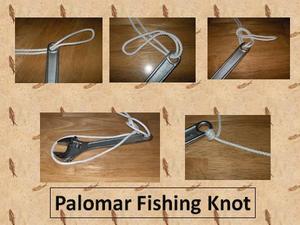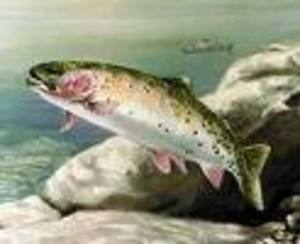I love to fish, but for years I had a huge problem. My idea of tying a fishing knot was tying a tennis shoe knot through the eye of a fishhook. I lost more fish, lure, and patience only managing to pull in a fish and line intact ever so often.
In frustration, I decided if I would buy a book and learn how to tie a fishing knot that wouldn’t loosen on the first nibble. I was looking at fishing lure and books in WalMart when an older gentleman came onto the same aisle to shop. He overheard a friend and me talking about fishing knots and noticed we were looking at books and even pre-tied hooks. I think he took pity on us, because he gave me a great lesson in tying fishing knots right there in WalMart. He stayed with me as I practiced. He corrected and watched as I practiced again and again. He was patient and before long, I knew how to tie several different fishing knots that would hold.
It’s my turn to share what I learned that day and on many summer evenings of fishing since.
Different knots are better for different types of fishing. You may find you prefer one to another because of the ease of learning how to tie the fishing knot, or the durability of the hold. This step-by-step guideline should get you started. It includes the palomar knot, improved cinch knot, uni knot, snelled uni knot, swivel knot,
How to Tie a Fishing Knot: Palomar Knot
Tie line to lures or hooks with the sturdy Palomar Knot. It is super easy to tie and holds extremely well. I use this knot more than most others when freshwater fishing. It works well for me. It is easy to learn. You may only need to practice once to master this knot. The Palomar Knot is not a fishing knot for large sport fishing. It does not tie well with heavier, thicker line. Freshwater fishing, for catfish, carp, crappie, or bass are reason enough to learn how to tie this fishing knot.
Steps to tying a Palomar Knot:
1. Run the line through the eye of the hook or lure.
2. Double back through the same eye hook, leaving a 3 to 4 inch loop on the other side of the hook.
3. Tie a knot in the double line above the eye, but do not pull it tight.
4. Pull the looped end of the line over the hook or lure.
5. Pull the knot tight. Pull the end of the line and the fishing line equally. Cut off any remaining tag line.
How to Tie a Fishing Knot: Improved Cinch Knot
The improved cinch knot is also an easy fishing knot to learn. It is strong and tends not to slip, when tied correctly. The improved cinch knot is usually the first fishing knot any fisherman learns to tie. I had forgotten it, but my father taught me how to tie the improved cinch knot when I was very young. It only took a little reminder to get back on board with this great little fishing knot.
Steps to Tying an Improved Cinch Knot:
1. Run the line through the eye of the hook or lure.
2. Bring the end of the line back up around the fishing line and twist it five times. Some fishermen prefer to twirl it.
3. Slide to looped coils together toward the eye of the hook.
4. Thread the end of the line through the loop above the eye.
5. Thread the line through the loop created by the coiled line.
6. Pull the line tight pulling both the end of the line (tag) and the fishing line. Try to keep the five coils from bunching or piling up. This will compromise the strength of the knot.
When a fish jerks your hook on this knot it pulls the knot tighter. Using the right weight line, this knot should not slip or break. It will happen occasionally, because we all get a little anxious when we know a fish is right there and sometimes tie our knots a little too quickly. That’s usually when we don’t tie them right and the fish gets away!
How to Tie a Fishing Knot: Uni Knot
Vic Dunaway, a well known southern fisherman and author of several fishing books, developed a knot that could be used equally well for freshwater or saltwater fishing. The uni knot is strong and versitale.
Steps to Tying a Uni Knot:
1. Run the line through the eye of the hook, lure, or swivel.
2. Bring the end of the line back toward the eye.
3. Similar to the cinch knot, twist the line from the eye six times. The difference in the uni knot and cinch knot is that you will twist the bottom of the line around the doubled part of the fishing line.
4. Pull the end of the line to slide the knot against the eye.
How to Tie a Fishing Knot: Snelled Uni Knot
A slight modification of the uni knot protects the knot from wear and tear.
Steps to Tying a Snelled Uni Knot:
1. Run the line through the eye of the hook, lure, or swivel.
2. Bring the end of the line all the way back down past the line.
3. Like the uni knot above, twist the line six times around the doubled part of the fishing line and the hook or lure.
4. Pull the line tight, up the hook toward the eye. The knot will remain below the line. Keep the coils from bunching or twisting as you tighten the knot.
How to Tie a Fishing Knot: Swivel Knot
Sport fishing, offshore, requires a lot of different tackle, lure, and the knowledge of a variety of superior knots for hanging on to the big fish you are after on the sea. Learning to tie a swivel knot will allow you to use a diversity of lure and tackle. It is usually tied to a lead line, or double line, but can be tied directly to a large hook. Swivel knots also allow you to tie weights or hooks on a separate line. Learn to tie a swivel knot before you begin large sport fishing.
Steps to Tying a Swivel Knot:
1. Using a swivel or a hook run a double line through the eye.
2. Twist the loop one time.
3. Pass the loop over the swivel or hook.
4. Flip the hook or swivel into the loop and double line. (See photo.)
5. Hold the double line and pull the swivel to pull the coils tight. Keep the coils straight. Do not allow them to gather or overlap.
6. Pull the double line tight to tighten the knot against the swivel or hook.





